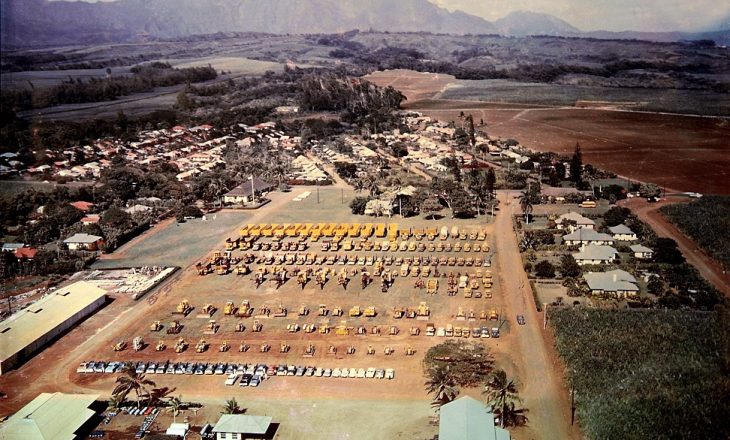Grove Farm Plantation Centralizes Operations in Puhi

During the 1920s, Grove Farm Plantation built Puhi Camp for its employees — a modern camp at that time located on what is now the campus of Kauai Community College.
Then, from 1934 to 1937, Grove Farm centralized its sugar operations away from Lihue to a site just south of Puhi Camp that had long been planted in sugar cane. During that time, brand-new facilities were built at Puhi under the direction of manager E. W. Broadbent and chief engineer William Moragne.
First, the antiquated Grove Farm office within Grove Farm Homestead was abandoned in favor of a freshly designed office by Kauai architect and Waimea Sugar Co. plantation manager Alan Faye Sr. that is still in use.
Construction of homes for office personnel and skilled employees followed, as well as up-to-date shops, warehouses and other buildings. The newly constructed, wood-framed, iron-sided Puhi shop housed facilities for a machine shop, carpenter shop, tractor shop and blacksmith shop.
 | Furthermore, railroad tracks were laid out to the shop, making the repair of locomotives possible within. (Of note is George Makaneole, Grove Farm’s only locomotive driver at the time.) A large warehouse comprised of three rooms for general storage and supplies was also constructed, as was a 12-truck capacity garage.Nearby, a service station with two 5,000-gallon diesel oil tanks was erected. Other buildings built at Puhi were a storage shed for plows, cultivators, caterpillars and other implements, a locomotive shed for housing Grove Farm’s locomotive, a horse shoeing shop, and a scrap iron, salvaged metal and building materials storage warehouse. Besides these buildings, a rock crusher, a crude oil storage plant, stables for 60 animals, scales for weighing trucks, etc., and a block machine for making hollow tile were built at Puhi. The stables, by the way, were completely ventilated, cool, airy and clean. |
